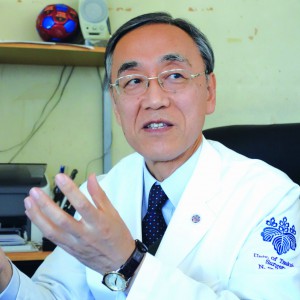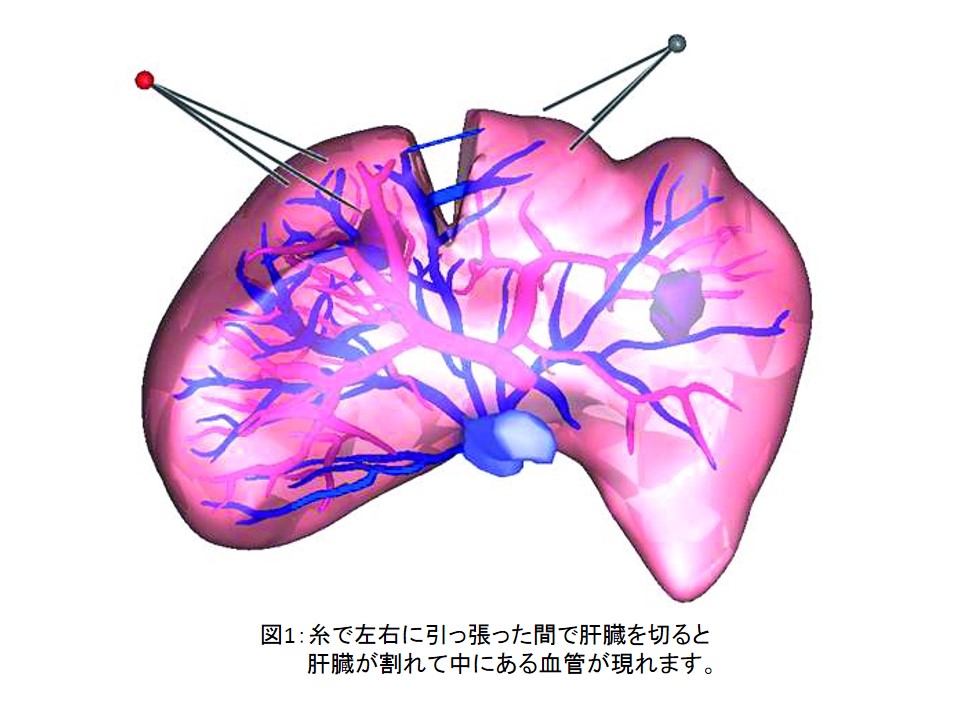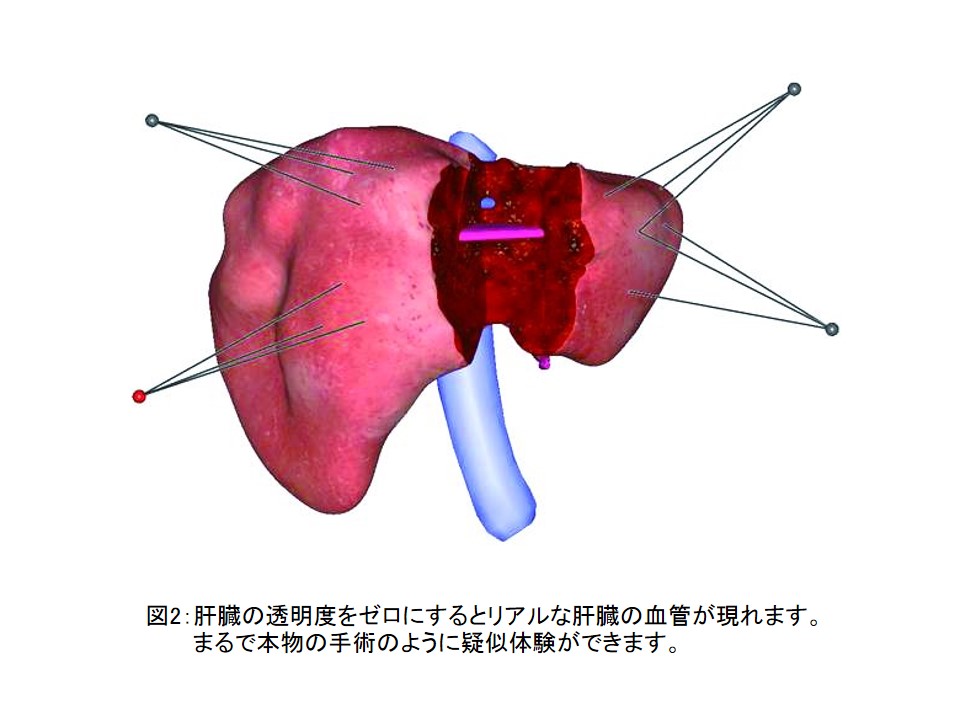キーワード:医工学連携、バーチャルリアリティ、手術シミュレーション、3D-CG、ハプティクス
http://intron.kz.tsukuba.ac.jp/3dcgvirtualhepatectomy/index.html
 がん治療の第一選択として手術が広く行われています。日本は手術による死亡率が低いため、安全に手術ができる国といわれています。しかしながら、外科医は10年以上の研修期間を要するため、日本の外科医師数は年々減少の一途をたどっており、20年後には現在の1/3になると予想されています。本リサーチユニットでは、質の高い外科治療を維持したまま研修期間の短縮を目指し、手術シミュレーションシステムの開発と教材づくりに取り組んでいます。
がん治療の第一選択として手術が広く行われています。日本は手術による死亡率が低いため、安全に手術ができる国といわれています。しかしながら、外科医は10年以上の研修期間を要するため、日本の外科医師数は年々減少の一途をたどっており、20年後には現在の1/3になると予想されています。本リサーチユニットでは、質の高い外科治療を維持したまま研修期間の短縮を目指し、手術シミュレーションシステムの開発と教材づくりに取り組んでいます。
工学・芸術学・医学の融合で3D-CGバーチャル手術シミュレーション
システムを開発
これまでの外科医の教育は、手術書を読み、手術を見て覚える、というものでした。現在の手術書は紙ベースで動きがなく、臓器の平面図しかないため、手術の流れや実際の視野をイメージすることが困難です。私たちのリサーチユニットでは、工学・芸術学・医学の最先端の技術を結集した「3D-CGバーチャル手術シミュレーションシステム」を開発しています。このシステムでは、バーチャルで臓器を自由に移動・変形させることができます。また、臓器から得たデータをもとに開発し、「力を加えるとどのくらい肝臓が変形するのか」や、「この部分にメスを入れた時に、どのような血管が出てくるのか」も、本物の臓器と同じように体験できます(図1、図2)。現在、肝臓の3D-CGバーチャル手術シミュレーションシステムを開発しており、今後、膵臓や骨盤の臓器などに対象を拡充していく予定です。


筑波大学から、日本の外科教育を変える
また、私たちは「21世紀の動く新手術テキスト」も開発しています。これはタブレットPCの中に、外科に関する全ての情報を入れ、さらに動きのある分かりやすいテキストに仕上げようというものです。
これまでは、外科医が1人で手術ができるまでに約15年もの長い研修期間が必要でしたが、3D-CGバーチャル手術シミュレーションシステムと、動く新手術テキストを使ってトレーニングを行なうことにより、これまでの見て覚える研修期間と比べて格段に研修期間を短縮することができます。筑波大学から日本の外科教育を変えて、日本の外科医減少防止と、さらなる外科治療レベルの向上に貢献したいと思っています。
社会への貢献・実績
● 画像解剖を重視する外科手術とIT技術の有機的結合と相乗効果は、医療界では最もインパクトあり。特に医学生のみならず、臨床に携わる医師の教育法として効果は多大
● 次世代型3D-CGバーチャル手術シミュレーションシステムのデータを地域や国で集積、共有できる環境を構築することで手術手技の評価、集合知的解析が可能
● 日本の外科治療のレベルの底上げを図り、日本の癌医療水準均霑化の推進に貢献
● 次世代型3D-CGバーチャル手術シミュレーションシステム、21世紀の動く新手術テキストが医学生、外科医にとって魅力的で効果的な教材となり、新たな手術の考案、創作に寄与し、外科医減少防止に貢献
(取材:平成25年11月13日)
Changing Surgical Education in Japan – For Safer and More Secure Surgery – : 3D-CG Virtual Operation Unit
Unit members : Kakeya, Hideki Kim, Sangtae 今井 寛 Takizawa Hotaka 福永 潔 Yano, Hiroaki
Key words:medicine-engineering liaison, virtual reality, operation simulation, 3D-CG, haptics

Surgery is widely applied as first-line cancer treatment today. With a low surgery-related mortality rate, Japan is regarded as a country providing safe surgical services. On the other hand, as a training period of more than 10 years is needed to become a surgeon, the number of Japanese surgeons is decreasing annually, and is likely to decrease to a third of the present number in the next 20 years. This research unit is engaged in the development of operation simulation systems and training materials, aiming to shorten the period of surgical training, while maintaining the level of surgical treatment.
Developing 3D-CG Virtual Operation Simulation Systems Combining Engineering, Arts, and Medicine
Up to the present, surgical education has been provided through reading manuals and observing surgical procedures. However, such paper-based manuals only show anatomical illustrations, and it is difficult to visualize each procedure and the visual field during surgery. Considering such a situation, this research unit has developed 3D-CG virtual operation simulation systems combining cutting-edge technologies in the fields of engineering, arts, and medicine. Using these systems, it is possible to virtually move and manipulate organs. They also enable users to simulate desired situations based on the entered data, such as “clarifying the degree of liver deformation when compressing” and “identifying blood vessels at the site of incision” (Figures 1 and 2). Currently, a new 3D-CG virtual operation simulation system for the liver is under development, and will be followed by those for the pancreas and pelvis.

Figure 1: Stretching the left and right sutures, and incising the liver between them to expose the inner blood vessels

Figure 2: Setting the degree of transparency of the liver at 0 to observe hepatic vessels; the system allows the realistic simulation of surgical procedures.
Changing Surgical Education in Japan from the University of Tsukuba
e have also developed the “21st Century Movable Surgical Textbook” to enter all surgery-related data in a tablet PC and use them as easy-to-understand and movable texts. Through reading-and-observing learning approaches, a training period of approximately 15 years was necessary for surgeons to become able to perform surgical procedures by themselves. Our 3D-CG virtual operation simulation systems and movable textbooks are expected to markedly shorten such a long training period. We aim to contribute to the improvement of the surgical treatment level and number of surgeons in Japan by changing surgical education from the University of Tsukuba.
Social contributions and achievements
● Accumulating data obtained from next-generation 3D-CG virtual operation simulation systems on community- and nationwide-bases and creating environments to share them, in order to evaluate surgical techniques and perform collective intelligence-based analysis
● Improving the surgical treatment level and standardizing the quality of cancer treatment services in Japan
● Contributing to the creation of new surgical techniques and maintenance of the number of surgeons by developing next-generation 3D-CG virtual operation simulation systems and the 21st Century Movable Textbook as useful and effective training materials for medical students and surgeons
